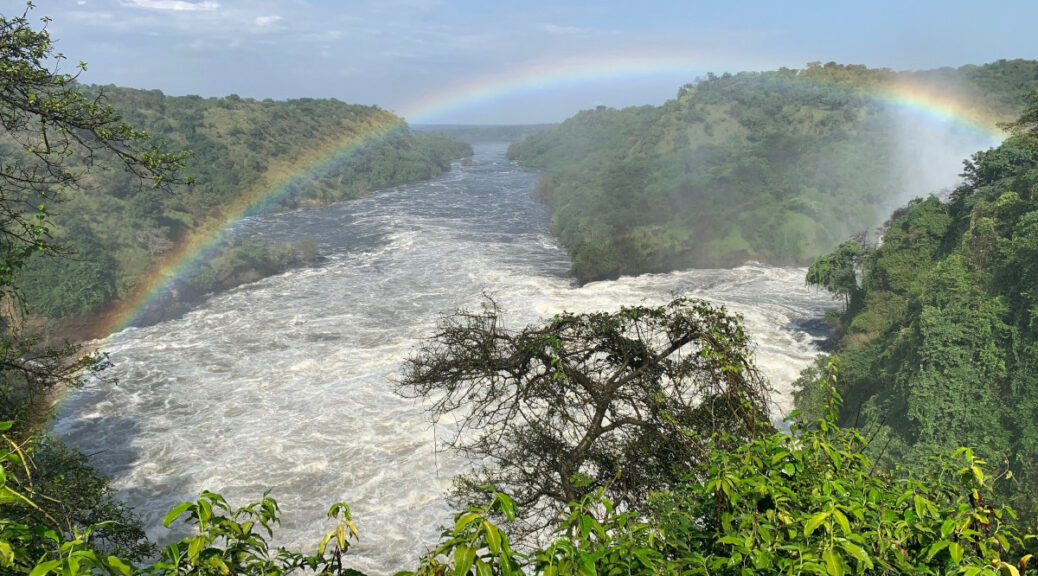As the Nile wends its way through Uganda, it powers through a narrow gap to create the spectacular Murchison Falls. A visit to the national park is a chance to experience the river’s different moods and see unique birds and wildlife. By Sam Pinnell
If, like us, you are on the lookout for the less-travelled path, take the back roads to Murchison Falls National Park in northwestern Uganda. The route leads along the country’s western edge, through the magnificent Budongo Forest, suddenly dropping down into the Rift Valley. You then drive along the valley floor parallel to Lake Albert with the mountains of the DRC in the distance on the far bank.
And if you appreciate the lesser-known sights, turn onto the Butiaba road. At the end you will find a half-submerged signpost marked “Sir Samuel and Lady Florence Baker Historical Trail”. In 1864, Sir Baker was the first European to see Lake Albert, named by him then in honour of Prince Albert. This trail was marked from Sudan to Murchison Falls and along the edge of Lake Albert by the descendants of the Bakers. It’s in commemoration of the 150th anniversary of their explorations of 1860–1870, and their efforts to abolish the slave trade. Based on the significantly increased water level, I think most of the trail is now sadly lost to history. It’s late afternoon when we finally arrive at Murchison River Lodge, right outside the park. We’re just in time for sundowners on the verandah overlooking the Nile.


The force of Murchison Falls
It’s a quiet night in the campsite, interrupted only by the noisy, voracious grass-mowing of the hippo very close to our tent. Up early for breakfast, we head to the park gate. Paying USD rates for park fees on the rand means we try and maximise our time inside. Our first stop is at the top of Murchison Falls. It’s incredible to see the huge expanse of the Nile River, pushing into a rock crevice. The power of the water and accompanying sound are overwhelming. It’s not possible to talk over the noise. Definitely a moment for appreciation and contemplation. The rocks are slippery, and in the swollen water level of the river the official railing has been washed away, so we tread carefully! We are treated to colourful rainbows over the water. After this furious descent, the river lazes downstream, eventually finding its way into Lake Albert.
The ferry that has for years carried vehicles and people across the Nile has been replaced by an enormous Chinese-built bridge. As we drive off the northern side, there is a swathe carved out of the bush where the road will ultimately go. We wonder what the long-term impact of this will be on the National Park. But for now, we enjoy our time on the green plains. We add Uganda kob antelope, patas monkeys and Rothschild giraffe to our mammal list. Our bird list gets the addition of a striking pair of Abyssinian ground hornbills. The male dazzles with his fuchsia pink crop. It’s green, green, green all around us, and the animals are plentiful. We opt to sit under a tree with our lunch, and be a part of it all.

Also read: Gorilla trekking in Uganda
Cruising the river
In the afternoon, we join the Wild Frontiers cruise upstream to the base of Murchison Falls. Our guide, Isaac, takes a slow pace. We spot black and white Colobus monkeys, colourful red-throated bee-eaters and a sleeping barn owl. It takes us a good two hours to get to the base of the falls. Disappointingly, the boat doesn’t get nearly as close to the waterfall as the marketing brochures show. We can’t even hear the thunderous roar so we are really glad we went to the top earlier to appreciate this properly. Wild Frontiers have cold drinks and snacks for sale onboard. Otherwise pack your own cooler box, sit back and enjoy the afternoon on the Nile.
The following morning we head downstream with another Wild Frontiers cruise. Our destination? The Lake Albert delta area to search for the elusive shoebill. The water is still and peaceful on the surface and the reflections of the riverbanks are just beautiful. We spot fish eagles perched in trees looking for breakfast and crowned cranes in the new sunlight. Also an African harrier-hawk (gymnogene) disguised in a palm tree and the noisy, chattering grey plantain-eaters. But no shoebill…. We did manage to see the very shy papyrus gonolek, but the shoebill waits for another day.

Is it worth a visit?
Murchison Falls National Park lived up to our expectations and more, as the visit to the top of the falls is even more impressive than we had hoped. You could easily spend more time in the game reserve section in search of the lions and leopards. But the main feature of the park is the mighty Nile River so pay it due time and respect – it won’t disappoint.
Looking to follow the less-travelled path to your destination? Tracks4Africa can show you the way. Our GPS maps, paper maps and guide books cover the full road network – on tar, gravel and sand. Our maps are enriched with points of interest relevant to independent overlanders, so you’ll know where to go for fuel, accommodation and more.

